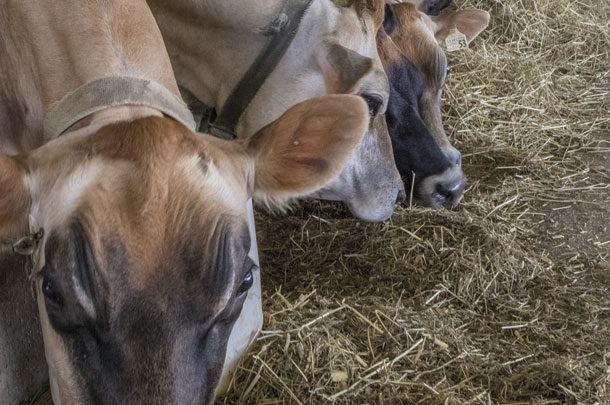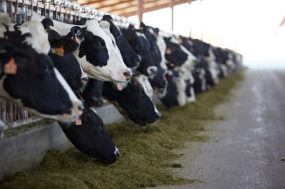In North American dairy herds, the incidence of clinical hypocalcemia, more commonly known as milk fever, is up to 7 percent. Having rather characteristic symptoms, it is easy for producers to detect it. Subclinical hypocalcemia is present in more than 50 percent of cases following calving and is harder to detect because the symptoms associated with it are far less visual.
Placental retention, metritis, displacement of abomasum and loss of milk production are among other issues related to hypocalcemia and have a significant financial impact on the farm.
As a producer or nutritionist, various strategies to limit this problem are at your disposal. Working with high or low intakes of dietary calcium is one of these possibilities. Also, minimizing potassium intake often helps to reduce problems around calving.
However, it is not always possible to apply these strategies to all farms, and they do not always work effectively against subclinical hypocalcemia. It is therefore important to have several solutions in your toolbox to deal with any situation listed above.
The use of negative dietary cation-anion difference (DCAD) in pre-fresh cows is the recognized strategy of the industry to maximize the release of bone calcium through a more active parathyroid hormone (PTH) early in lactation. This strategy makes the cow as independent as possible when the demand for calcium increases.
Providing an anionic ration for pre-fresh cows makes it possible to limit the development of metabolic diseases, maximize dry matter intake and obtain optimal milk production. To do this, the use of a palatable anionic source is recommended to maximize consumption during this critical period.
Depending on the amount of anion, the DCAD program can be partially or fully acidified. As a result, the more acidified the ration, the more active the PTH will be and the higher the serum calcium (amount of calcium in the blood) will be available in the hours following calving. Therefore, a fully acidified program is favoured when management allows it.
Since the cow’s metabolic adaptation occurs in the weeks before calving, having validation tools is essential to ensure a successful lactation. In a quick and easy way, this strategy can be verified through the urinary pH before calving. Thus, it is possible to react quickly and stay in control if a readjustment of the anion dosage is necessary.
Secondly, it is also possible to validate the effectiveness of the program by determining blood calcium 48 hours after calving.
The goal to achieve when working with a fully acidified program is to obtain a urine pH of 5.5 to 6.0. However, several factors, other than the dosage of anions, influence the effectiveness of the program. To ensure success in transition, having control over what cows consume is a priority.
Different parameters must be validated to maximize the success of the program, and here are some to remember:
1. Mineral analysis of water
The impact of water consumption during lactation is well-known because of its demand required for milk production. However, water consumption during the dry period and in pre-fresh cows may vary from one individual to another.
Thus, water with a rather basic pH or having a cation content such as sodium or calcium may play a role in the effectiveness of the program. Without necessarily recommending water treatment, it may be relevant to consider mineral water analysis when balancing the DCAD program, especially if the results do not fully reflect what has been predicted initially.
2. Moisture of the ration
All factors affecting sorting will certainly have a significant impact on the effectiveness of the program. To begin with, a diet that is too dry will limit the adhesion of the anions to the silage particles, and therefore, it is possible the anions will be unfortunately swept at the end of the day when the feedbunk is cleaned.
This obviously causes economic losses in addition to a feed program that is definitely inefficient. To avoid such a situation, a dry matter content of 45 to 50 percent is targeted.
3. Particle length
The particle size of the various feeds greatly influences sorting of the ration. In an ideal world, achieve the most uniform cutting length possible. With even particle size, the cow will not be able to sort its ration and the consumption of anions will be more uniform.
4. Free-choice hay
The presence of free-choice hay, in addition to a basic ration, can influence the effectiveness of the program. This type of management does limit the control we have on the dry matter intake of cows.
Cows that do not like the taste of anions will most likely consume more dry hay, so the actual DCAD of their ration consumed will probably be far from the one calculated by the software.
However, this situation represents the reality of many dairy producers. Depending on the objectives of the producer, it is important to take the time to validate the best approach according to current management.
5. Homogeneity of the ration
It is well-known there can be a difference between the ration on paper and what cows actually consume. However, this variation should not be excessive and may be due to human or mechanical error in the amounts of ingredients added to the mixer.
This variation may also be due to a lack of homogeneity of the ration. The lack of homogeneity may, in turn, be caused by multiple factors such as the order of incorporation of ingredients into the mixer or inadequate mixing time.
However, mixing a small amount of ingredients in a large mixer can also cause a problem. This situation is often observed in smaller herds where the number of pre-fresh cows is also small.
6. Overcrowding
An area that contains too many animals will result in a variation of dry matter intake from one cow to another, as competition at the feedbunk is increased. Consequently, if consumption is variable, the results will vary just as much. This aspect is important, regardless of the feeding strategy chosen.
Obviously, not all factors have been addressed here. In addition, some are more applicable to tiestall and others to freestall barns. However, these key factors will allow you to ask yourself the right questions and validate some management issues that will be equally beneficial in lactation and pre-fresh cows.
With a significant financial impact, hypocalcemia is a problem that deserves attention. The current context in dairy production is making producers more efficient and effective. Emphasis on pre-fresh group management is one of the ways to achieve this goal. ![]()
PHOTO: Solutions to prevent the risk of metabolic diseases, such as clinical hypocalcemia and subclinical hypocalcemia, that can influence the success of calving. Photo by Mike Dixon.

-
Gabrielle L. Dumas
- Technical Representative
- DCL Animal Health and Nutrition
- Email Gabrielle L. Dumas










